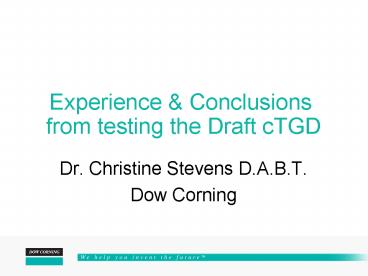Experience PowerPoint PPT Presentation
1 / 16
Title: Experience
1
Experience Conclusions from testing the Draft
cTGD
- Dr. Christine Stevens D.A.B.T.
- Dow Corning
2
Characterization according to market risk
properties
- Substance volatile siloxane
- Classification and Labelling F N (R11, R50)
- Use identification
- Polymers Intermediates
- Used in personal care
- Off-site chemical intermediate
- Automotive
3
(No Transcript)
4
Environmental Emission Estimation
- Method Exposure Tools
- ECETOC TRA
- EUSES (European Union System for Evaluation of
Substances) - cTGD Part A Questionnaire
- AISE exemplification based on detailed
discussions with a customer to obtain their
estimation of potential losses - Output from AISE exemplification compared with
EUSES output - At all stages where more accurate information was
available, EUSES defaults were overwritten - Conducted for personal/domestic chemical
intermediate use
5
Environmental Emission Estimation
6
Prediction of Regional Concentrations
PECRegional
- Regional background reflects all EU inputs from
all sources - Regional background obtained by dividing total
tonnage by 10 (10 theoretical regions) - However this may be amended if all the production
use occur in a single region - Quantities emitted to the various compartments
depends on the phys/chem properties of the
material. This is calculated by EUSES
automatically - The Regional Background is also added when
calculating Local Emissions
7
Prediction of Regional Concentrations
8
Prediction of Local Concentrations (PECLocal)
- Local concentrations are calculated using the
local production or processing tonnages, combined
with EUSES defaults for emission fractions
released to the environment number of emission
days per year (the infamous A B tables) - These are highly conservative defaults should
be overwritten if site specific data is
available - Recognising this, ECB intends that in future
re-iterations of the model, e.g. the EUSES
Spreadsheet version, the AB tables will be
replaced by specific information - To improve the output of the model very detailed
information is required.
9
Prediction of Local Concentrations
10
Risk Characterization Ratios (RCRs)
11
Key Experience and conclusions
- Draft cTGD part A questionnaire is too detailed
for many DU. - Likely that will need two levels of detail for
the questionnaire for customers with without
expertise - Good quality feedback on the questionnaire is
essential, but, more detail required to avoid
generating over cautious RA - Questionnaire does not address re-use of waste
(on DU site) or cleaning of vessels process
lines, or maintenance
12
Key Experience and conclusions
- Use descriptors in TGD EUSES do not correspond
- Descriptor for technical function has limited
value is difficult to assign What happens if
product serves more than one technical function?
e.g. - Adhesion Promoter
- Curing Agent
- Sizing Agent
- Also may encounter confidentiality problems as
customers do not want to reveal exact function of
an ingredient in a formulation - Problem that procedures vary from one customer to
another (even if doing same basic process), such
that exposures will differ. Must therefore base
it on worst-case or sub-divide into e.g. two
levels of environmental protection.
13
Key Experience and conclusions (re environment)
- ECETOC TRA Phase 1 not adequate for Tier 1
Environmental assessment too simplistic
automatically requires a Tier 2 assessment - Tier 2 Tool EUSES (European Union System for
Evaluation of Substances) - Developed to support Existing Substance RAs
- Based on Industry Use Categories (IC/UC) and A
B Emission Tables - Complex requires expert user
- Large amount of detailed information required to
avoid the application of highly conservative
defaults - Initial input data may generate RCRs gt 1.0 for
some compartments
14
Key Experience and conclusions
- EUSES is a good tool but require a high level of
expertise unlikely that all but the large DUs
have this. Therefore subdivide customers - Work with key customers to develop use-specific
ES - Translate into generic form to send to other less
skill-rich DU - Process has only evaluated a single substance,
will be much more complex for preparations - It is not clear how useful these tools or the
Phase II developments will be to assess
environmental exposure of Preparations
15
Additional tools
- EU TGD Spreadsheet Version
- Simpler to use than EUSES
- Not reliant on A B Tables (ECB to drop these as
no substantiation for some emission values)
specific emission data can be inputted - Enables impact of changes in input data to output
data to be seen at once - But errors exist in the spreadsheet code, which
still need rectifying
16
Improvements to Existing Tools
- ECETOC TRA Phase II objective is to
- Generate a user-friendly tool
- Based on EU TGD Spreadsheet Version, with the
proviso - Inconsistencies with EUSES are corrected
- Will be able to calculate safe emission levels
- Enable Tier 1 assessment based on minimal data
input - Enable higher Tier assessment based on more
detailed data input - Identifies the Target Compartment of concern
calculates the quantity of material which can be
used without exceeding RCR of 1 - Provides a Customer Scaling Tool for the customer
to conduct his/her own compliance check for
specific site conditions - Should also include option to calculate partial
vapour pressures for complex mixtures/preps

